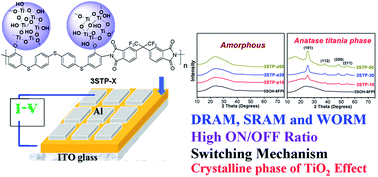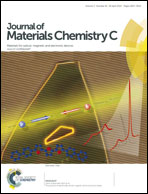Electrically programmable digital memory behaviors based on novel functional aromatic polyimide/TiO2 hybrids with a high ON/OFF ratio†
Abstract
A novel solution-processable sulfur-containing poly(o-hydroxy-imide) 3SOH-6FPI with pendant hydroxyl groups and the corresponding polyimide 3SOH-6FPI/TiO2 hybrids were synthesized from diamine 4,4′-bis(4-amino-3-hydroxyphenylthio)diphenylsulfide (3SOH-DA) and 4,4′-(hexafluoroisopropylidene)diphthalic anhydride (6FDA), and used for memory applications. To enhance the memory behavior, different amounts of TiO2 were introduced into 3SOH-6FPI and the corresponding tunable memory properties were investigated. The hydroxyl groups on the backbone of 3SOH-6FPI could provide reaction sites for organic–inorganic bonding and the homogeneous hybrid thin films could therefore be obtained by controlling the mole ratio of titanium butoxide/hydroxyl groups via sol–gel reaction. The resulting hybrid films having different TiO2 concentrations from 0 wt% to 50 wt% exhibited electrically programmable digital memory properties from DRAM, SRAM, to WORM with a high ON/OFF current ratio (108). Furthermore, from the results of the current–voltage I–V characteristics, the crystalline phase of titania reveals higher trapping ability to increase the retention time in the ON state. In order to get more insight into the switching mechanism of 3SOH-6FPI/TiO2 hybrid memory devices, molecular simulation and electrode effects were also discussed in this study.


 Please wait while we load your content...
Please wait while we load your content...